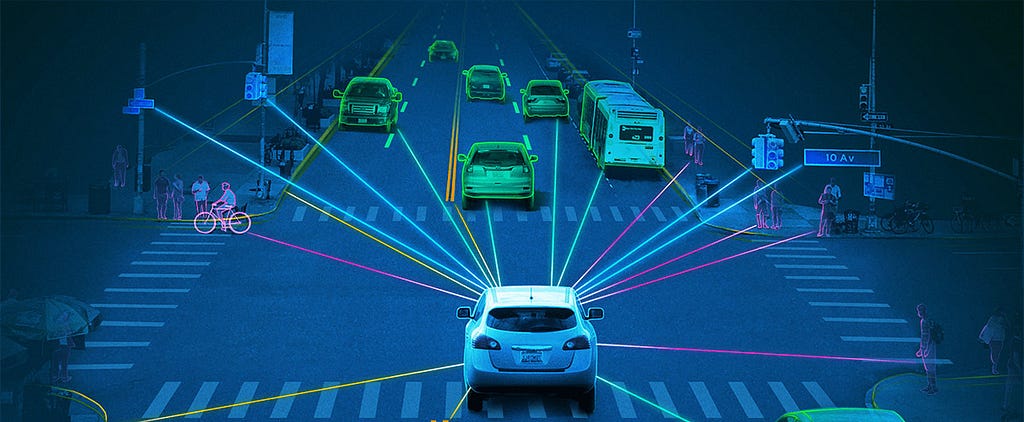LiDAR Annotation: Boosting AI’s Perception Capabilities
LiDAR or light detection and ranging can be described as a remote sensing technology that utilizes lasers to measure distances. It is used for producing accurate three-dimensional information with regard to shape and features of surrounding objects. It is also useful in scenarios requiring high-precision and high-resolution information regarding shape and location of objects.Modern LiDAR systems are capable of transmitting up to hundred thousand pulses in a second. The measurements that originate from these pulses are gathered into a point cloud. A point cloud is a group of coordinates representing objects sensed by the system. It is used for creating a 3D model of space around the LiDAR.LiDAR systems are a combination of four elements; laser, scanner, sensor, and GPS. Let’s discuss each one below.Laser: Transmits light pulses (ultraviolet or infrared) on objects.2. Scanner: Adjusts the speed of the laser in scanning and targeting objects, along with the ultimate distance reached by the laser.3. Sensor: Traps the light pulses emitted on their return as they are reflected from the surfaces. The measure of the total travel time of a reflected light pulse enables the system to estimate the distance of the surface.4. GPS: It is used for tracking the location of the LiDAR system to ensure the distance measurements are accurate.Photo by Christin Hume on UnsplashSignificance of LiDAR AnnotationLiDAR annotation is used for making detailed 3D maps to boost the perception capabilities in many systems. Deep learning tasks on LiDAR data are variables of semantic segmentation, object detection and classification. Hence, annotation of LiDAR data is quite similar to image annotation for the same tasks. With respect to object detection, a 3D bounding box is placed in place of a 2D one for images. For semantic segmentation, a single label is needed for each point in the point cloud as a single label is required for each pixel in an image.Types of LiDAR SystemsLiDAR systems are of two types — airborne and terrestrial. Airborne is self-explanatory, however, terrestrial LiDAR is concerned with objects on the ground and scans in all directions. The objects could be static, i.e fixed to a tripod or building or mobile, i.e. fixed to a car or train.Let’s take the use case of autonomous vehicles and understand how LiDAR annotation helps in navigating vehicles on the road to prevent accidents and comply with traffic rules. The LiDAR sensor acquires data from several thousand laser pulses each second. An onboard computer is used for analysing the ‘point cloud’ of laser reflection points for animating a 3D representation of its environment. Ensuring the accuracy of LiDAR in creating a 3D representation of its environment involves training the AI model with annotated point cloud datasets.The annotated data permits autonomous vehicles in detecting, identifying and classifying objects. This assists in precise detection of road lanes, moving objects, and real-world traffic situations by autonomous vehicles. Car makers have already begun integrating LiDAR technology in advanced driver assistance systems (ADAS) for making sense of the dynamic traffic environment surrounding the vehicle. These systems enable accurate split-second decisions as per hundreds of careful calculations derived from hundreds of thousands of data points to ensure the self-driving car’s journey is safe and secure.SummaryHence, LiDAR annotation plays a critical role in perception enhancement of autonomous systems. Through precision labeling of LiDAR point cloud data, autonomous vehicles, drones, etc can acquire a better understanding of their surroundings, detecting objects and making informed decisions. LiDAR annotation as a process requires assignment of labels for individual points, drawing bounding boxes, or performing semantic and instance segmentation. But it also poses challenges like complexity, ambiguity and labeling consistency. Adherence to industry best practices, using specialized tools and adopting future trends will enhance the efficacy of LiDAR annotation leading to advancement of autonomous systems.LiDAR Annotation: Boosting AI’s Perception Capabilities was originally published in Becoming Human: Artificial Intelligence Magazine on Medium, where people are continuing the conversation by highlighting and responding to this story.

LiDAR or light detection and ranging can be described as a remote sensing technology that utilizes lasers to measure distances. It is used for producing accurate three-dimensional information with regard to shape and features of surrounding objects. It is also useful in scenarios requiring high-precision and high-resolution information regarding shape and location of objects.
Modern LiDAR systems are capable of transmitting up to hundred thousand pulses in a second. The measurements that originate from these pulses are gathered into a point cloud. A point cloud is a group of coordinates representing objects sensed by the system. It is used for creating a 3D model of space around the LiDAR.
LiDAR systems are a combination of four elements; laser, scanner, sensor, and GPS. Let’s discuss each one below.
- Laser: Transmits light pulses (ultraviolet or infrared) on objects.
2. Scanner: Adjusts the speed of the laser in scanning and targeting objects, along with the ultimate distance reached by the laser.
3. Sensor: Traps the light pulses emitted on their return as they are reflected from the surfaces. The measure of the total travel time of a reflected light pulse enables the system to estimate the distance of the surface.
4. GPS: It is used for tracking the location of the LiDAR system to ensure the distance measurements are accurate.

Significance of LiDAR Annotation
LiDAR annotation is used for making detailed 3D maps to boost the perception capabilities in many systems. Deep learning tasks on LiDAR data are variables of semantic segmentation, object detection and classification. Hence, annotation of LiDAR data is quite similar to image annotation for the same tasks. With respect to object detection, a 3D bounding box is placed in place of a 2D one for images. For semantic segmentation, a single label is needed for each point in the point cloud as a single label is required for each pixel in an image.
Types of LiDAR Systems
LiDAR systems are of two types — airborne and terrestrial. Airborne is self-explanatory, however, terrestrial LiDAR is concerned with objects on the ground and scans in all directions. The objects could be static, i.e fixed to a tripod or building or mobile, i.e. fixed to a car or train.
Let’s take the use case of autonomous vehicles and understand how LiDAR annotation helps in navigating vehicles on the road to prevent accidents and comply with traffic rules. The LiDAR sensor acquires data from several thousand laser pulses each second. An onboard computer is used for analysing the ‘point cloud’ of laser reflection points for animating a 3D representation of its environment. Ensuring the accuracy of LiDAR in creating a 3D representation of its environment involves training the AI model with annotated point cloud datasets.
The annotated data permits autonomous vehicles in detecting, identifying and classifying objects. This assists in precise detection of road lanes, moving objects, and real-world traffic situations by autonomous vehicles. Car makers have already begun integrating LiDAR technology in advanced driver assistance systems (ADAS) for making sense of the dynamic traffic environment surrounding the vehicle. These systems enable accurate split-second decisions as per hundreds of careful calculations derived from hundreds of thousands of data points to ensure the self-driving car’s journey is safe and secure.
Summary
Hence, LiDAR annotation plays a critical role in perception enhancement of autonomous systems. Through precision labeling of LiDAR point cloud data, autonomous vehicles, drones, etc can acquire a better understanding of their surroundings, detecting objects and making informed decisions. LiDAR annotation as a process requires assignment of labels for individual points, drawing bounding boxes, or performing semantic and instance segmentation. But it also poses challenges like complexity, ambiguity and labeling consistency. Adherence to industry best practices, using specialized tools and adopting future trends will enhance the efficacy of LiDAR annotation leading to advancement of autonomous systems.
LiDAR Annotation: Boosting AI’s Perception Capabilities was originally published in Becoming Human: Artificial Intelligence Magazine on Medium, where people are continuing the conversation by highlighting and responding to this story.























